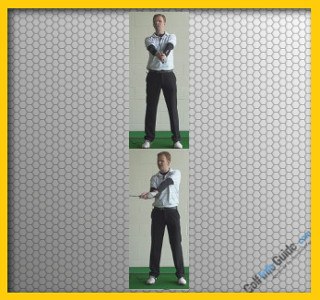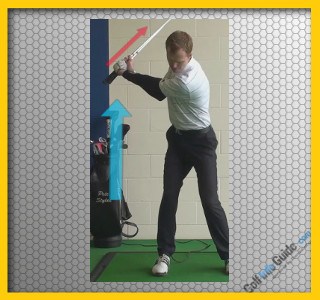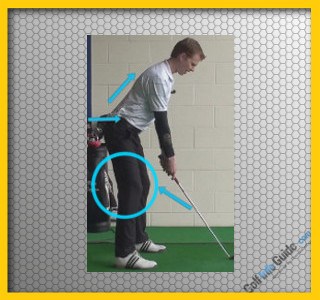A reverse pivot is a common fault in the golf swing that can range from moderate to severe. The reverse pivot is where the weight doesn’t transfer correctly. For right handed golfers, a reverse pivot would see the majority of weight in the backswing load into the left side. In the downswing the weight moves into the right side. During a correct transfer in the backswing, we would see the loading of weight move slightly into our right side. Just before we start our downswing the weight starts moving to the left. In the end, a correct finish position would see 85% of our weight posted onto our left side.
A reverse pivot causes many problems from “casting the club” or “coming over the top” to slicing or even topping the ball. Over time, the major problem that arises will be injury to the lower back, left knee and hip.
The following tips will help you understand the proper swing sequence and correct a reverse pivot.

The Baseball Swing Drill is an effective drill to help understand proper weight transfer in the golf swing. Baseball players and golfers share very similar swing patterns. There have been very few, if any at all, major league baseball players that hit with a reverse pivot. One would think they won’t be very successful. In baseball, the swing is all reaction to a ball moving towards the batter. When the ball gets released from the pitcher’s arm, the batter starts initiating his swing with a slight shift of weight to his back foot, and then a pronounced kick of the weight into their front foot as the ball approaches. When timed correctly, the results are very apparent with hits and homeruns.
In golf the sequence is similar with the only difference being that the ball is static. It just sits there. It’s not curving or moving 95mph. However, if you place a power hitter and professional golfer beside each other, their swings function identically. The Baseball Swing Drill is very simple. Take a club and hold it waist high with your feet close together standing in an upright posture. Next you will start your swing and at the same time you’ll step toward the target with your lead foot. The idea is to make a full swing ensuring most of your weight finishes on the left side. Try this drill in practice without a ball to start and then progress to trying it with a handful of golf balls. It will definitely feel different if you struggle with a reverse pivot but it will only take a handful of practice sessions to become comfortable with the sequence.

The next drill will most likely take place at home or in the gym. All you will need is a soccer ball or 10 lb weighted ball. The heavier the ball used will work more core muscles and assist in generating speed in the golf swing. Rotation with a ball drill is another simple and effective drill for helping an individual understand proper sequencing in the golf swing.
Grad the ball and get into your golf posture holding the ball just above waist high. The next step is to slowly start your swing while trying to keep your legs and lower body very still. You will swing the ball back to your hips. Then engage your core and swing the ball over to the other hip ensuring that majority of the weight finishes on the lead side. You will want to do 10 of these swings and then make 5 golf swings with a regular club. Repeat 5 times. You will begin to feel a significant difference in weight transfer and it will also give you a great core workout.

Generally speaking those who suffer from a reverse pivot also struggle with poor posture. It is very common to see a reverse pivot in senior golfers as they have postural issues and the pivot is a result of the body compensating for this.
The most common form of poor posture is what we call a C-Spine. This is very apparent and noticeable from a distance. Starting from the bottom, the spine comes out from the pelvis relatively straight and as it progresses upwards it begins to curve like a C. We were often told to not “Slouch”. Ultimately, this posture in golf shuts down the body’s ability to rotate.
To create a better posture, stand straight up and run a golf club from the top of your head down along your spine. The club should be touching your spine all the way down. Next you’ll bend slightly from the hips and flex your knees. The club should remain on your spine. This will help you feel proper posture and assist in creating more rotation in your golf swing.






